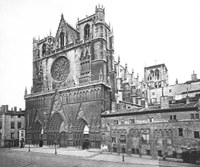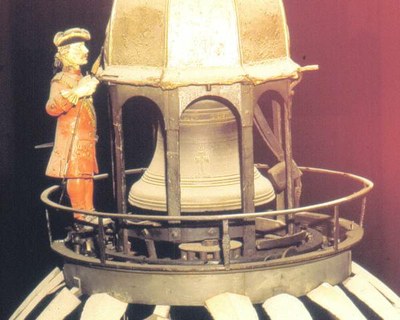I-Historical
III-Automata and chiming mechanisms
|
Cathedral of St. John the Baptist |
 |
Historical
An official document dated November 23, 1379, written in Latin records the existence of a clock in the Saint-John cathedral in Lyons.
In 1598, the clock was restored by a citizen of Lyons, Levet with the assistance of the citizen of Basle, Lippius. The engraving of 1598 is the earliest known illustration of the clock which appears in a gothic style. In 1660, the Canons Counts of Lyons decided to reactivate the clock and ordered the clockmaker of Lyons, Guillaume Nourrisson to undertake this important task. The essential features of the clock are listed there : the rooster on the summit of the dome, the angels striking on bells the hymn of Saint-John the Baptist « Ut queant laxis », the scene of Annunciation, the statues representing the days of the week, the astrolabe, the perpetual calendar and a novelty, the oval minutes dial with a hand of variable length (p. 19) .
 |
 |
 |
| 1598 | 1660 | 2010 |
The decoration turns into neo-renaissance style as it still is today. In 1779, the clockmaker of Lyons, Pierre Charmy, brings the movement up to date and builds the anchor which is signed with his name. He adds a new automaton, the Swiss Guard dressed in red who, on the top of the campanile walks around the great bell with his halberd.
 |
 |
| The Swiss Guard |
The anchor, signed "CHARMY FECIT" |
During the Revolution, in 1793, all signs reminding of royalty were removed : crowns, armorials, fleurs de lys and even the caryatids applied to the clock thus disappeared. During most of the 19th century the dock remained silentuntil in 1894 the Commission of Historical Monuments ordered the firm Chateau of Paris to restore the dock. In 1954, the firm Ungerer of Strasbourg completely overhauled the clock, cut a new escape wheel and added the Computes Ecclesiastics calculated for the years 1954 to 2019.
Restoration of 1992-93
The automata and statues of polychrome wood were disinfected with gamma rays by the Atomic Energy Commission in Grenoble and thereafter restored by the firm Claveranne, which was used to work for the National Museums. All photos were taken by photographer Guy Bussery

Statues (60 cm) representing the days of the week (during the restoration)
Document Actions



